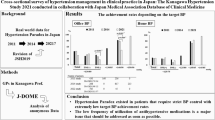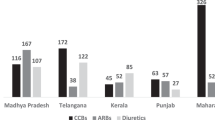Abstract
Failure of physicians to adhere to hypertension guidelines may partly account for the failure to achieve blood pressure (BP) goals in clinical practice. The aim of this trial is a comprehensive description of the approach of physicians in the management of high BP among primary care patients. It will primarily assess what are the Reasons for not Intensifying an Antihypertensive Treatment (RIAT), when predefined individual BP goals are not achieved. Open intervention survey was conducted in 17 countries in Latin America, Eastern Europe, Africa and Asia in family practices, government and private clinics. The registry is based on a three-step epidemiological design. Step one shall identify guidelines and recommendations taken as reference in each country for the management of hypertension. Step two will assess the variance between individual targets defined by physicians in their practice compared to guidelines and recommendations. Step three is a prospective registry where physicians collect patient data at baseline; determine individual target BP values. Several follow-up visits are proposed to monitor achievement of these targets. Step three of RIAT aims at providing responses to several key objectives. Recruitment is under way aiming at enrolling 33 000 patients. To identify, what is the BP targeted according to the risk factor profile and what are the reasons for not modifying an antihypertensive treatment when BP goals are not reached, and to analyse the type of antihypertensive drugs prescribed according to compelling indications and to assess the percentage of patients reaching target figures.
This is a preview of subscription content, access via your institution
Access options
Subscribe to this journal
Receive 12 digital issues and online access to articles
$119.00 per year
only $9.92 per issue
Buy this article
- Purchase on Springer Link
- Instant access to full article PDF
Prices may be subject to local taxes which are calculated during checkout
Similar content being viewed by others
References
De Backer G, Ambrosioni E, Borch-Johnsen K, Brotons C, Cifkova R, Dallongeville J et al. European guidelines on cardiovascular disease prevention in clinical practice. Third Joint Task Force of European and Other Societies on Cardiovascular Disease Prevention in Clinical Practice. Eur Heart J 2003; 24: 1601–1610.
Joint National Committee. The sixth report of the Joint National Committee on prevention, detection, evaluation, and treatment of high blood pressure. Arch Intern Med 1997; 157: 2413–2446.
World Health Organization. 1999 World Health Organization-International Society of Hypertension Guidelines for the Management of Hypertension. Guidelines Subcommittee. J Hypertens 1999; 17: 151–183.
World Health Organization. 2003 World Health Organization (WHO)/International Society of Hypertension (ISH) statement on management of hypertension. J Hypertens 2003; 21: 1983–1992.
Chobanian AV, Bakris GL, Black HR, Cushman WC, Green LA, Izzo Jr JL et al. Seventh report of the Joint National Committee on Prevention, Detection, Evaluation, and Treatment of High Blood Pressure. Hypertension 2003; 42: 1206–1252.
Hajjar I, Kotchen TA . Trends in prevalence, awareness, treatment, and control of hypertension in the United States, 1988–2000. Jama 2003; 290: 199–206.
Dusing R, Weisser B, Mengden T, Vetter H . Changes in antihypertensive therapy – the role of adverse effects and compliance. Blood Press 1998; 7: 313–315.
Degli Esposti E, Sturani A, Di Martino M, Falasca P, Novi MV, Baio G et al. Long-term persistence with antihypertensive drugs in new patients. J Hum Hypertens 2002; 16: 439–444.
Hyman DJ, Pavlik VN . Self-reported hypertension treatment practices among primary care physicians: blood pressure thresholds, drug choices, and the role of guidelines and evidence-based medicine. Arch Intern Med 2000; 160: 2281–2286.
Hyman DJ, Pavlik VN . Characteristics of patients with uncontrolled hypertension in the United States. N Engl J Med 2001; 345: 479–486.
Ferrari P, Hess L, Pechere-Bertschi A, Muggli F, Burnier M . Reasons for not intensifying antihypertensive treatment (RIAT): a primary care antihypertensive intervention study. J Hypertens 2004; 22: 1221–1229.
Cuspidi C, Michev I, Meani S, Severgnini B, Sala C, Salerno M et al. Awareness of hypertension guidelines in primary care: results of a regionwide survey in Italy. J Hum Hypertens 2003; 17: 541–547.
Margolis KL, Rolnick SJ, Fortman KK, Maciosek MV, Hildebrant CL, Grimm Jr RH . Self-reported hypertension treatment beliefs and practices of primary care physicians in a managed care organization. Am J Hypertens 2005; 18: 566–571.
Frijling BD, Spies TH, Lobo CM, Hulscher ME, van Drenth BB, Braspenning JC et al. Blood pressure control in treated hypertensive patients: clinical performance of general practitioners. Br J Gen Pract 2001; 51: 9–14.
Fagard RH, Van Den Enden M, Leeman M, Warling X . Survey on treatment of hypertension and implementation of World Health Organization/International Society of Hypertension risk stratification in primary care in Belgium. J Hypertens 2002; 20: 1297–1302.
Mancia G, Pessina AC, Trimarco B, Grassi G . Blood pressure control according to new guidelines targets in low- to high-risk hypertensives managed in specialist practice. J Hypertens 2004; 22: 2387–2396.
Banegas JR, Segura J, Ruilope LM, Luque M, Garcia-Robles R, Campo C et al. Blood pressure control and physician management of hypertension in hospital hypertension units in Spain. Hypertension 2004; 43: 1338–1344.
Spranger CB, Ries AJ, Berge CA, Radford NB, Victor RG . Identifying gaps between guidelines and clinical practice in the evaluation and treatment of patients with hypertension. Am J Med 2004; 117: 14–18.
Steckelings UM, Stoppelhaar M, Sharma AM, Wittchen HU, Krause P, Kupper B et al. HYDRA: possible determinants of unsatisfactory hypertension control in German primary care patients. Blood Press 2004; 13: 80–88.
Fretheim A, Oxman AD, Flottorp S . Improving prescribing of antihypertensive and cholesterol-lowering drugs: a method for identifying and addressing barriers to change. BMC Health Serv Res 2004; 4: 23.
Burt VL, Whelton P, Roccella EJ, Brown C, Cutler JA, Higgins M et al. Prevalence of hypertension in the US adult population. Results from the Third National Health and Nutrition Examination Survey, 1988–1991. Hypertension 1995; 25: 305–313.
Fagard RH, Van den Enden M . Treatment and blood pressure control in isolated systolic hypertension vs diastolic hypertension in primary care. J Hum Hypertens 2003; 17: 681–687.
Reid CM, Thrift AG . Hypertension 2020: confronting tomorrow's problem today. Clin Exp Pharmacol Physiol 2005; 32: 374–376.
Acknowledgements
This study is supported by Sanofi-Aventis Intercontinental. The study was registered with the Australian Clinical Trial Registry with the number ACTRN012605000163606.
Author information
Authors and Affiliations
Consortia
Corresponding author
Rights and permissions
About this article
Cite this article
Ferrari, P., Kim, SK., Wu, C. et al. Aim, design and methods of the ‘reasons for not intensifying antihypertensive treatment’ (RIAT): an international registry in essential hypertension. J Hum Hypertens 20, 31–36 (2006). https://doi.org/10.1038/sj.jhh.1001937
Received:
Revised:
Accepted:
Published:
Issue Date:
DOI: https://doi.org/10.1038/sj.jhh.1001937
Keywords
This article is cited by
-
Reasons for therapeutic inertia when managing hypertension in clinical practice in non-Western countries
Journal of Human Hypertension (2009)



